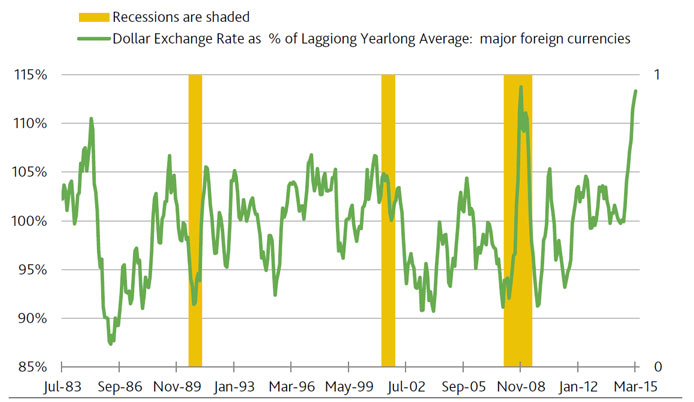According to Moody’s latest, conceivably, dollar exchange rate appreciation might substitute for a fed funds rate hike. All else the same, the need for a higher fed funds rate recedes as the dollar exchange rate strengthens. A persistently strong dollar is likely to weaken the pricing power of US businesses and labor. Since bottoming in the summer of 2011, the US dollar has soared higher by a cumulative 29% against a basket of major foreign currencies. In the context of an economic upturn, the dollar’s ongoing ascent is the steepest vis-a-vis major foreign currencies since the cumulative 31% surge of the five years ended 2000, or when core PCE price index inflation grew by merely 1.6% annualized, on average, notwithstanding real GDP’s comparably measured growth rate of a scintillating 4.3%.
 Lately, the strong dollar has put downward pressure on the prices of US exports and imports. February 2015’s -5.9% annual plunge by the US export price index was the deepest such setback on record for a mature US economic recovery. The dollar’s earlier surge of the five-years-ended 2000 saw the US export price index slide by -0.8% annualized, on average. Moreover, February’s price index for US imports excluding petroleum products fell by -1.8% annually. Expect more of the same according to the -1.3% average annualized drop by the US core import price index during the five-years-ended 2000.
Lately, the strong dollar has put downward pressure on the prices of US exports and imports. February 2015’s -5.9% annual plunge by the US export price index was the deepest such setback on record for a mature US economic recovery. The dollar’s earlier surge of the five-years-ended 2000 saw the US export price index slide by -0.8% annualized, on average. Moreover, February’s price index for US imports excluding petroleum products fell by -1.8% annually. Expect more of the same according to the -1.3% average annualized drop by the US core import price index during the five-years-ended 2000.
